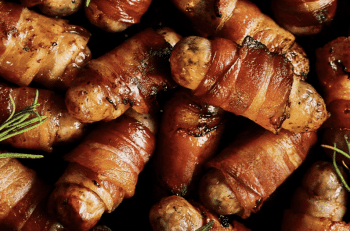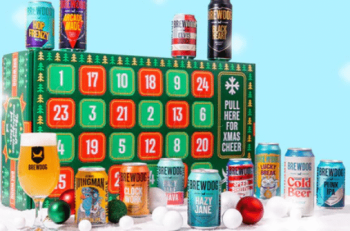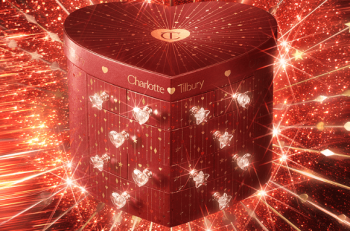Christmas cakes are a traditional and delicious part of the festive season in the UK but with so many varieties and recipes to choose from, how do you find the perfect one for your taste and budget?
 Here, the Christmas.co.uk team will explore the history and origins of Christmas cakes, the different types and flavours available, and some tips and tricks for making and decorating your own.
Here, the Christmas.co.uk team will explore the history and origins of Christmas cakes, the different types and flavours available, and some tips and tricks for making and decorating your own.
Whether you prefer a classic fruitcake, a modern sponge-based creation, or something more exotic, we will help you discover the best Christmas cake for you and your family.
We will also share some of the best places to buy or order Christmas cakes online, from supermarkets and independent bakeries, as well as some of the most popular and highly rated Christmas cake recipes from BBC Good Food.
So, get ready to celebrate Christmas with a rich, moist and festive cake that will impress your guests and bring joy to your table.
The history and origins of Christmas cakes
Here are some fun facts about the history and origins of Christmas cakes in the UK.
- The earliest form of Christmas cake was a plum porridge that was eaten to break the fast on Christmas Eve. This began in medieval England and before Christmas, Christians used to fast and Eastern Christians still do it for six weeks. Advent was a time of repentance and until the practice changed in 1917, people had to fast and avoid meat on Fridays during Advent.
- Later, other ingredients such as dried fruits, spices, honey and butter were added to make it richer and tastier.
- In the 16th century, the plum porridge evolved into a plum cake that was eaten at Easter. This cake was similar to the modern Christmas cake, but with less fruit and more flour and eggs.
- In the 18th century, the plum cake became associated with Twelfth Night, the end of the 12 days of Christmas on January 5th. The cake was often decorated with elaborate icing and edible or non-edible ornaments. It also contained a bean or a pea that would determine the king or queen of the Twelfth Night party.
- In the 19th century, during the Industrial Revolution, the Twelfth Night celebrations declined as people had to return to work after Christmas. The cake was then moved to Christmas Day and became known as the Christmas cake. It also became more dense and moist, with more fruit and alcohol, to support the heavy icing and decorations.
- The traditional Christmas cake in the UK is a dark and rich fruit cake that is soaked in brandy, rum, whisky or sherry. It is covered with a layer of marzipan and then a layer of royal icing. This icing is made from egg whites that are softly beaten, icing sugar and lime or lemon juice (sometimes). When it becomes hard it will be the decoration for biscuits and Christmas cakes. It can be topped with festive motifs such as snowmen, holly leaves, ribbons or candles – or snowflakes (see later).
- There are also regional variations of Christmas cakes in the UK, such as the Whisky Dundee from Scotland, which is a light and crumbly cake with less fruit and more whisky; or the Yorkshire Christmas cake, which is also a fruit cake with spices and sometimes alcohol such as whisky or sherry. Yorkshire Christmas cake is also eaten with cheese.
Other countries have their own versions of Christmas cakes, such as the Panettone from Italy, which is a yeast-leavened bread, usually made with candied fruit peels, raisins, almonds and brandy. There is also the Roscón from Spain, a traditional Spanish dessert that is usually eaten at Christmas. This is a sweet, ring-shaped bread, decorated with icing sugar and candied fruit. Known as Roscón de Reyes or King’s Cake, it is also traditionally eaten on January 6th – the day of the Three Kings.
The Bûche de Noël from France is a traditional dessert dished up after Christmas dinner. Made of a roll of light sponge cake, it is coated in coffee buttercream or chocolate, and then made to resemble tree bark to replicate the tradition of Yule log burning.
And the Rosca de Reyes from Mexico, a traditional pastry that is eaten during the festivities – but traditionally on January 6th – Three Kings’ Day. This sweet bread has a wreath shape and covered in candied fruits to represent the crowns of the three wise men. The big difference between this and the Mexican version is that it contains a small plastic Jesus figurine as a baby – whoever finds this is then expected to host a Candelaria Day party on 2 February.
The different types of Christmas cakes
There are different types and flavours of Christmas cakes available, including:
- Traditional fruit cake: This is the most common and classic type of Christmas cake, made with dried fruits, nuts, spices and alcohol. It is usually covered with marzipan and royal icing and decorated with festive motifs. Some examples are Mary Berry’s Christmas cake – we offer up her classic Christmas cake recipe later – and Rick Stein’s Christmas cake.
- Sponge-based cake: This will need to be made closer to Christmas since it will only store for up to five days. It is a lighter and softer alternative to fruit cake, made with flour, eggs, butter and sugar. It can be flavoured with various ingredients, such as chocolate, orange, cranberry, gingerbread etc. It is usually coated with buttercream, cream cheese or chocolate frosting, and decorated with sprinkles, meringues, candy canes, etc. Some examples are chocolate and orange Cointreau cake, pure gold Christmas drip cake, or winter wonderland cake.
There are also other types of cake that can be enjoyed at Christmas time, such as pavlova, yule log, cheesecake, trifle, etc. These cakes are often inspired by different cuisines or traditions, such as Italian, French or Australian.
They can be made with various ingredients, such as cream, custard, fruit, nuts, chocolate, etc. Some examples are pavlova wreath, Bûche de Noël, white chocolate and cranberry cheesecake, or sherry trifle.
When should I start making my Christmas cake?
For a rich, boozy and deeply fruity Christmas cake, make it 12 weeks before the big day, and then ‘feed’ it with the liquor or fruit juice of your choice.
If you prefer a Christmas cake with a milder flavour and want to follow a tradition that began in Victorian times, make your cake on ‘Stir-Up Sunday’. This year it is the 26th November – it is held on the last Sunday before the beginning of Advent – so just before the chaos of December.
Stir up Sunday dates for your diary:
- 2023 November 26
- 2024 November 24
- 2025 November 23
- 2026 November 22
- 2027 November 28
- 2028 November 26.
Making your Christmas cake and pudding on Stir-Up Sunday is a lovely way to begin the festive celebrations. Your children or grandchildren can help, you can create a party atmosphere and fill your home with delicious aromas.
How do you ‘feed’ a Christmas cake?
Feeding a Christmas cake will keep it moist as the flavour matures over the weeks and months after it has been made. Traditionally, cakes have been fed with strong liquor such as brandy as the alcohol adds a decadent taste and preserves the cake so it can be stored for months without spoiling.
Fruit juice such as cranberry, apple or orange are great non-alcoholic alternatives though they will add sweetness. For a less sugary flavour use tea instead. You will need to wrap the cake after feeding to ensure it doesn’t spoil until it is ready to be eaten.
After you’ve made your Christmas cake, make tiny holes all over with a skewer or cake tester then wrap it tightly in greaseproof paper and pop it in an airtight container.
Then every week, check the moistness of the sponge, and if it feels dry to the touch, pour your chosen ‘food’ all over cake, it will reach the heart of your cake through the skewer holes. Once done, re-wrap and store in a cool, dark place.
Don’t feed your cake if it leaves a residue on your finger when you test it, this means it is already moist and adding more food will make it soggy. Check it again the next week as normal.
What is the best Christmas cake recipe?
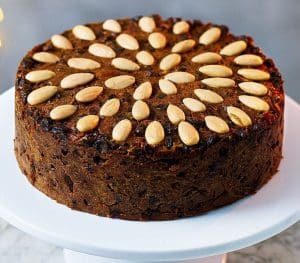
Pre-soaked fruit
450g currants
175g raisins
- 175g sultanas
- 50g chopped candied peel
- 50g chopped glace cherries
Ingredients
- ½ teaspoon salt
- 225g dark brown soft sugar
- 225g plain flour
- ¼ level teaspoon grated nutmeg
- ½ level teaspoon ground mixed spice
- 4 large eggs
- 1 dessertspoon black treacle
- 225g spreadable butter
- zest of 1 lemon and 1 orange
- 50g chopped almonds (skin on)
For feeding and topping:
- Brandy or Armagnac to ‘feed’ the cake
- If you’re not planning on icing your cake, top it with whole blanched almonds.
Method
Place all the fruit into a big bowl and mix in the brandy the night before you plan to make your cake. It’s important to soak it under a cloth for at least 12 hours.
Pre-heat your oven to 140°C (if it’s a fan oven to 120°C) It’s important your cake cooks slowly at a low temperature.
Sift the flour, salt and spices together and then add the sugar, eggs, and butter. Mix until it is smooth and fluffy. Bit by bit add the soaked fruit, chopped nuts and orange and lemon zest.
Carefully spoon the mixture into a buttered or lined cake tin and smooth it down so it’s even. If you’re using them, place the almonds in circles or a star shape.
To protect your cake surface from burning, place baking parchment with a hole in the centre loosely on top of the cake tin (not on the mixture)
Bake your cake on the lowest shelf for 4 hours (don’t open the door before) then check with a cake tester and give it another half an hour if needed. It should feel bouncy to the touch when ready.
Once baked, place on a cooling rack and make feeding holes in the surface. When your masterpiece is completely cold, feed with brandy, wrap with parchment and pop it in an airtight tin.
How to decorate a Christmas cake
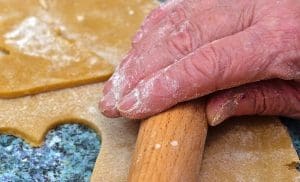
Here are some general tips and advice on how to decorate a Christmas cake.
Marzipan
Love it or hate it, marzipan is an important part of decorating a Christmas cake as it provides a stable base for the icing and adds a touch of sweet, almond flavour to the warmth and spice of the fruit cake.
Unless you’re a perfectionist who must have crisp edges on your royal icing or a marble smooth fondant, adding a marzipan layer is easy to do. Once your cake is cold, use a pastry brush to coat it with lots of apricot jam, this will help the marzipan to stick and taste delicious.
Use ready-made marzipan, Christmas is stressful enough! Dust your work surface with icing sugar, then roll out the marzipan, and aim for the thickness of a one-pound coin.
Place the marzipan over the cake, smooth the top and then trim the edges of the marzipan. Don’t worry too much if it isn’t an exact fit, just squish the edges close to the cake so the icing lays flat.
Icing
Royal icing gives a crisp, smooth finish, even if you’re a beginner. It has a hard texture, so add a couple of drops of glycerine when mixing to make it softer. Royal icing absorbs colour, so it should be thick enough to hide the yellow of the marzipan.
Fondant icing will give your cake a smooth and glossy finish, but it can be tricky to get right. Buy your fondant ready rolled and take your time when placing it on the cake, if there are imperfections a cake sash or ribbon will hide them. Leftover fondant can be used to decorate your cake. Use it to make snowmen, snowballs or banks of snow.
The finishing touch
When decorating a Christmas cake, the possibilities are endless. Create a fun festive scene with cake toppers, use fresh cranberries and hessian ribbon for a rustic look or add iced gingerbread stars and houses for an edible finishing touch.
Feeling ambitious about creating a real wow factor for a Christmas cake? Then check out cake lace which looks stunning and with the right kit and some simple skills it is easy to achieve. Watch below!
oooOooo
How To Use The Wonder Cakes Snowflake Lace Mat To Make Sugar Snowflakes
Nothing says more about festive food than having it covered in snowflakes – and here is a great way to do that for your Christmas cake.
It is surprisingly easy, and you just need a lace mat and some ready-made icing. You can make your own, but the ready-made icing really does work a treat!
After baking in an oven, the snowflakes peel away and can then be coloured using food dye and piping gel to secure them to your cake.
The finished effect is simply amazing!
This process is also great fun for children (of all ages) to create a unique Christmas cake this year.
oooOooo




